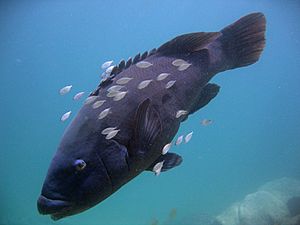Achoerodus viridis facts for kids
Quick facts for kids Achoerodus viridis |
|
|---|---|
 |
|
| Conservation status | |
| Scientific classification | |
 |
|
| Red = Eastern blue groper | |
| Synonyms | |
|
The eastern blue groper (Achoerodus viridis) is a cool fish that lives in the ocean off southeastern Australia. You can find them from Hervey Bay in southern Queensland all the way down to Wilsons Promontory in Victoria.
These fish like to hang out in rocky areas along the coast, usually about 40 meters (130 feet) deep. When they are young, baby gropers live in beds of seagrass in estuaries (where rivers meet the sea).
What do they eat? Eastern blue gropers love to munch on small sea creatures. Their diet includes things like molluscs (like snails and clams), crabs, sea urchins, and a type of sea squirt called cunjevoi.
Adult male gropers can grow quite large, up to 100 centimeters (39 inches) long! Female gropers are a bit smaller, usually less than 70 centimeters (28 inches) long. In 1998, the eastern blue groper became the official state fish of New South Wales.
Where Blue Gropers Live
The eastern blue groper is found only along the southeastern coast of Australia. Their home stretches from Mooloolaba in southern Queensland down to Wilsons Promontory in southern Victoria. This area also includes the eastern part of the Bass Strait. They prefer rocky places in the ocean, living at depths of up to 40 meters (130 feet).
How Blue Gropers Behave
Eastern blue gropers mostly eat crabs, shrimps, molluscs, and echinoderms (like sea urchins). Young gropers, called juveniles, live in seagrass beds. There, they mostly eat small crustaceans, which are like tiny crabs or shrimp.
One super interesting thing about this fish is that it's a sequential hermaphrodite. This means they start their lives as females! As they get older and bigger, usually when they are at least 60 centimeters (24 inches) long, they change into males.
Blue gropers become ready to have babies when they are about two to three years old. They usually breed between July and September. Their tiny babies, called larvae, float around in the water as plankton at first. Later, they settle down in seagrass beds, which are safe nurseries for them.
Protecting the Blue Groper
The area where the eastern blue groper lives is not very big, less than 64,000 square kilometers (25,000 square miles). These fish grow slowly and can live for a long time. It takes about twelve to fifteen years for a new generation of gropers to grow up.
Years ago, too many blue gropers were being caught, especially by spear fishing. This caused their numbers to drop. But in 1972, the government in New South Wales stepped in. They made it illegal to spear fish or commercially fish for eastern blue gropers.
Thanks to these rules, the number of blue gropers in the wild seems to have become stable. Because of this, the IUCN (a group that tracks endangered species) now lists the eastern blue groper as "Near Threatened". This means they are not in immediate danger, but we still need to keep an eye on them.
See also
 In Spanish: Achoerodus viridis para niños
In Spanish: Achoerodus viridis para niños


